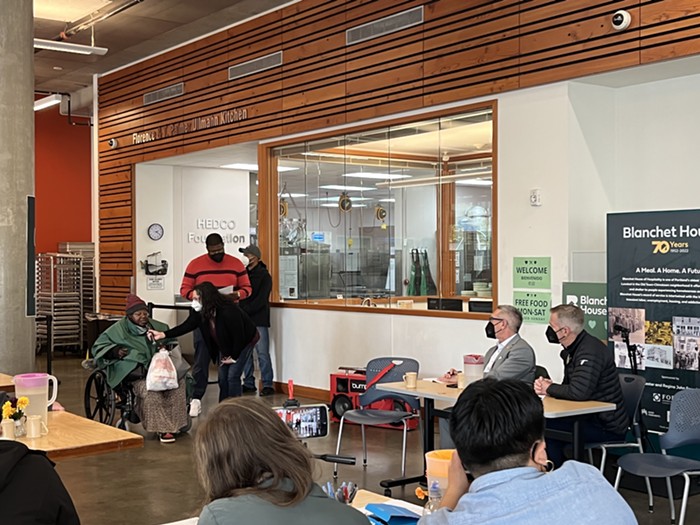ANYONE DESPERATE for a seat at the Alberta Street Pub on a recent Friday evening was in luck.
The bar top was crammed with drinkers. The covered outdoor seating area was full up. However, though the rain had cleared, Alberta Street’s once-popular uncovered smoking patio was completely deserted—bereft of beer and mirth.
Small placards in the middle of the abandoned tables told the tale: “Smoking or vaping (of any product) is no longer permitted anywhere on our patio.”
That’s a message that’s keeping bar owners up at night.
Earlier this year, a change to state administrative rules quietly upended seven-year-old standards for what constitutes an acceptable outdoor smoking area at Oregon bars (and other public places and workplaces in the state).
The change modified what counts as an “enclosed space,” where smoking is prohibited under Oregon’s Indoor Clean Air Act—and rendered an untold number of Portland patios off-limits to smokers in the process. Bar owners, caught off-guard, now argue the change was snuck into a rulemaking process without adequate notice.
Some who’ve already been forced to comply say their businesses are in peril at a time when rising rents are already pushing small businesses asunder. Owners whose illegal patios haven’t been flagged are trying their best to keep a low profile, and dreading the day when a health department employee strolls in with bad news.
“I’m freaking out,” says John Crockett, owner of the Nest on Southeast Belmont, who received notice several weeks ago that his patio no longer satisfied the state’s rules. Since the smoking porch closed, he says, a good chunk of his clientele has migrated elsewhere. “I’m losing hundreds [of dollars] every day. I don’t think I’ll be able to last six months if this keeps up.”
The pinch is being felt all over town.
“As soon as we went non-smoking, the customers started leaving,” says Christopher Gutierrez, co-owner of the Night Light Lounge on Southeast Clinton.
Gutierrez says he was among the first bar owners to get word of the new rules, when a county employee informed him in April that there was a complaint about his patio. He had a choice: Either risk a $500 fine any time someone was spotted puffing, or send his smoking customers elsewhere. Gutierrez estimates his business is down 20 percent ever since.
“We tried to spin it as an upside: ‘Hey, our patio is now non-smoking!’” he says. “It did not work. Our patio is basically unused now.”
Laina Amerson, owner of the Alberta Street Pub, says her late-night business has evaporated since she got word her bar was out of compliance.
“Part of the problem is that we have catered to smokers,” she says. “We’ve lost all of our smoking regulars.”
The changes the state enacted marked a sudden shift for bar owners who may have dumped thousands of dollars into outdoor seating to court a smoking clientele.
Under the new rules [PDF], a patio is deemed unfit for smoking if it’s enclosed by walls on two sides and has a ceiling. That’s a change from a rule in place from 2009 until last December, which said three walls and a ceiling were off limits.
A “wall” under existing regulations, can be many things. It can be made of mesh or latticing and still trigger regulation. It can be short, with an ample gap allowing airflow. And since even patios without ceilings apply, an area could be deemed off limits for smokers if it’s surrounded by three waist-high partitions and nothing more.
Some bar owners the Mercury spoke with about the change wouldn’t go on the record, fearful that their patios would be the next to close. Even some who have been flagged were reticent to be quoted. But, to a person, they all say the regulations came out of the blue.
Public records indicate they have a point.
When the Oregon Health Authority (OHA) announced last year that it was tweaking its administrative rules, it said it was doing so to comply with two recently passed bills—one that regulated e-cigarettes and vape pens, and another allowing food to be served at “certified smoke shops.”
“All the bars were like, ‘Fine, we don’t need to contest this at all,’” said one Portland bar owner who asked not to be identified.
Minutes [PDF] from a pair of rulemaking meetings last August show bars and restaurants had no representatives in attendance as discussion turned to something besides food and vaping. Committee members wanted to redefine what constituted an “enclosed space” under the rules.
“There will likely be resistance from some business owners, however, this is an opportunity to minimize exposure to secondhand smoke,” the minutes read.
The OHA stands by the rule changes.
“We were responding to concerns by the public and by people enforcing the law,” says Karen Girard, manager of the agency’s Health Promotion and Chronic Disease Prevention Section. “There is no safe level of exposure to second-hand smoke. The surgeon general has been very clear about that.”
And the Multnomah County Health Department cheered the agency on.
“Over the years, our staff has observed a growing number of shelters built for smoking that utilize loopholes in the definitions of what it means to be ‘unenclosed,’” county Environmental Health Services Director Jae Douglas wrote in a December 2015 letter. “Our main concern for this request is that a clear definition will provide a workplace free of tobacco smoke...”
But by any measure, OHA made its intentions opaque to the general public.
An October 2015 notice [PDF] for three meetings on the proposed rule changes specified that they would regulate e-cigarettes and allow food and drink at smoke shops, among other things. But it only vaguely alluded to new rules for patios, saying the change “amends and adds definitions...” without any hint of how bars would be affected.
Letters [PDF] the OHA sent to Oregon liquor licensees in December were even cagier, only mentioning new regulations on vape pens.
The result: The new rules went into effect in January, and confusion and panic has reigned since.
Bar owners “didn’t know about it,” says Erik Vidstrand, a county tobacco program specialist who enforces state smoking rules at local bars. “A lot of them don’t understand it.”
It’s not just a lack of understanding or that the changes came as a complete surprise, bar owners say. The state’s complaint-based enforcement of the new rules has led to an uneven playing field. Some bars have had their patios shuttered, while similarly illegal patios elsewhere remain cloudy and packed.
Owners are hoping to fight back. Crockett, of the Nest, has met with other bars and is researching attorneys for potential legal action. Others say they’ve contacted their elected officials, or are marshaling their own lawyers.
No one’s sure what happens next—only that something has to change.
“I am not going to lose my bar over this,” Crockett says. “That’s the whole reason we have a patio. Who else is going to sit out there in the friggin’ winter?”












